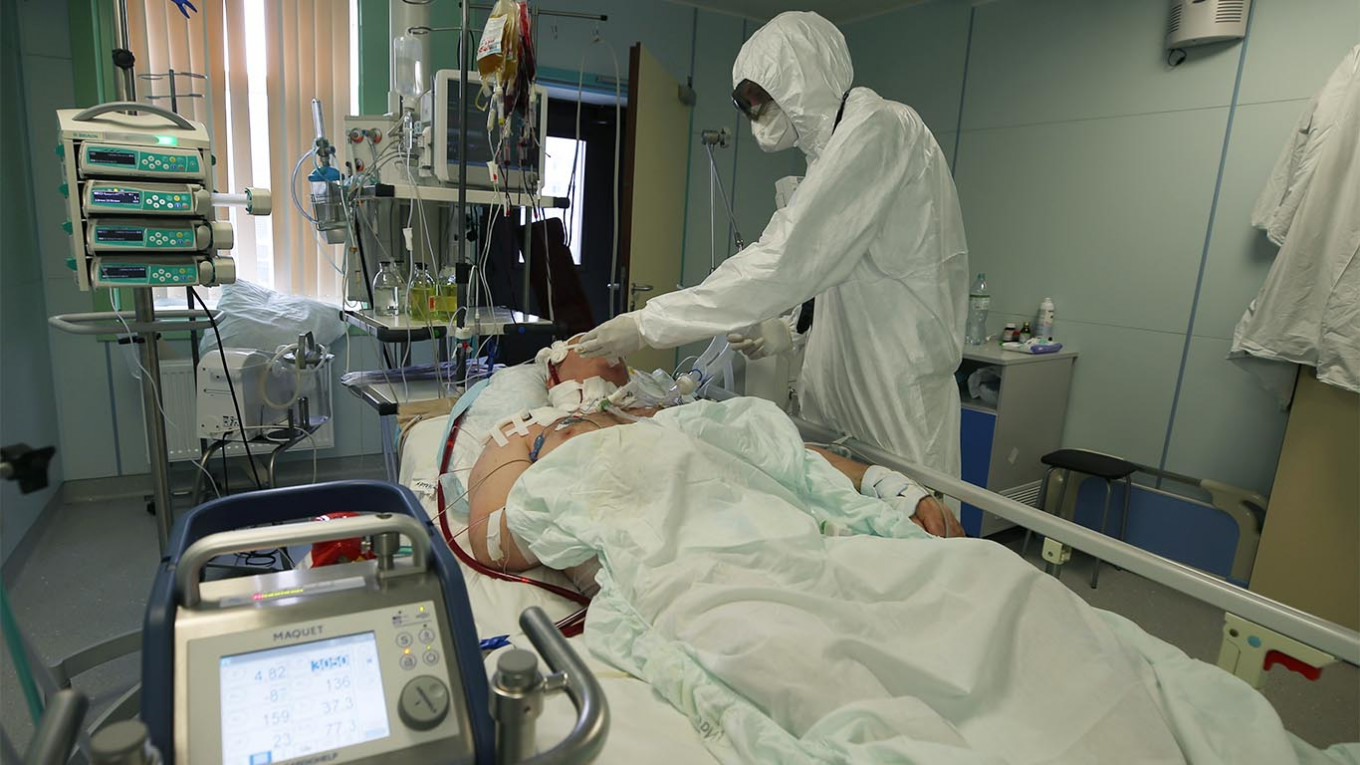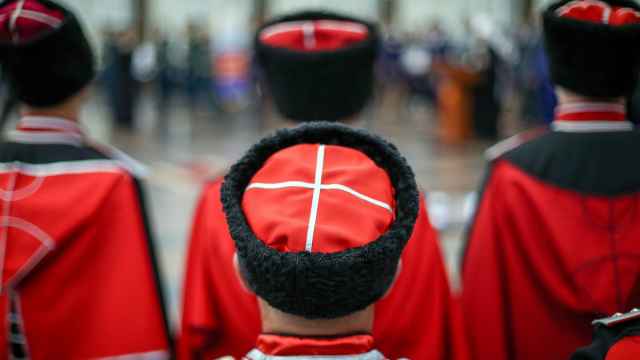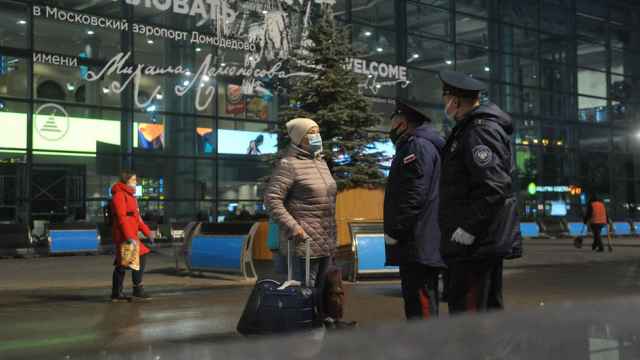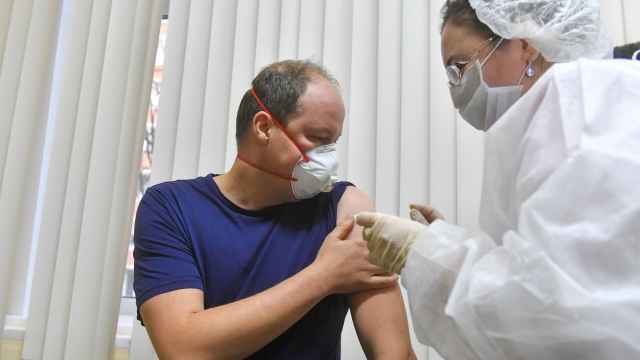The death toll from the coronavirus across many Russian regions could be many times higher than official statistics show, analysis of new data by The Moscow Times suggests.
Experts pointed to systemic underreporting of deaths, and highlighted a complex incentive structure and political relationship between the Kremlin and Russia’s governors in the regions.
They believe that by discouraging regions from reporting bad news, insisting they keep the virus under control and providing loose guidelines on how to count deaths, Russia has opened the door for regions to falsify, manipulate and delay accurate reporting of the spread of the virus.
Figures published by Russia’s statistics agency Rosstat last week show Russia recorded more than three times as many excess fatalities in May and June than the daily Covid-19 death counts published by Russia’s pandemic task force and used by politicians and media outlets to assess the spread of the virus.
Across many of Russia’s 85 regions, the discrepancy is even wider.
Dozens reported their most deadly May and June — the most recent months for which detailed fatality data is available — in a decade, registering hundreds of unexplained excess fatalities.
The new information raises fresh questions about how seriously swathes of the country have been affected by the pandemic, and the impact insufficient data could have had on Russia’s response.
Counting fatalities
Russia’s coronavirus statistics have come under scrutiny since the beginning of the outbreak, when officials heralded a robust testing regime as the reason for the country’s curiously low death rate.
Like other countries, Russia publishes a daily tally of new infections and deaths from the virus. The numbers are compiled by local authorities and both a national and regional count are published every morning.
“In many regions, the statistics have nothing to do with reality at all,” said Tatiana Mikhailova, a statistician who has been tracking the virus outbreak since the beginning and regularly raises concerns about data.
As the only official source of real-time information on the virus, the daily numbers are nevertheless widely reported on and carry serious weight in assessing the spread of the virus, managing the response and comparing Russia to other countries.
But Mikhailova told The Moscow Times that the quality is so poor, “it makes no sense to draw medical, virological, or epidemiological conclusions from them.”
As of Aug. 11, those figures said Russia had recorded 897,599 infections and 15,131 fatalities — placing Russia fourth and eleventh in the global league tables.
New more detailed information on deaths being published by regional registry offices — with a significant delay — is now starting to show just how wrong Russia’s original fatality count is.
The data shows that Russia saw 26,360 excess fatalities in May and June, compared with the average death tally over the previous five years, while Russia’s coronavirus task force reported just 9,303 fatalities from Covid-19 over the same period.
Meanwhile, dozens of regions saw an even wider discrepancy, with a sharp acceleration in deaths during May and June which was only partially — and in some cases not at all — reflected in the official Covid-19 death tally.
Some 27 of Russia’s 85 regions reported their most deadly June in a decade, while May also set a 10-year high for deaths in 20 regions.
That jump looks even starker against a backdrop of declining mortality rates in recent years. Not a single region set a 10-year high for fatalities in January, February or March this year, and Russia as a whole saw the lowest number of deaths in a decade over that period.
While many countries have seen jumps in fatalities that exceed their official coronavirus death tolls, experts say there are a number of specific Russia factors at play.
“Essentially all Russian regions are doing their best to artificially suppress the headline death count,” said Mikhail Tamm, a statistician at the Higher School of Economics (HSE).
“The most innocent way of doing this is to distinguish deaths ‘from coronavirus’ and ‘with coronavirus’ — where the main cause of death is recorded as some other chronic illness — and then report only the ‘from coronavirus’ number as a headline figure.”
Tamm is referring to the four-tier classification guidelines the Russian health system uses to determine precisely how deaths are related to the coronavirus. Under these, local authorities can give the main cause of death as:
- Covid-19, confirmed by testing
- Suspected Covid-19, not confirmed by testing
- Not Covid-19, but the virus was confirmed in the patient and had a significant impact in triggering “fatal complications” from another disease
- Not Covid-19, the virus was confirmed in the patient but it did not have a significant impact on their death
In a policy which runs counter to World Health Organization guidelines — which says all deaths related to Covid-19 should be counted as such “unless there is a clear alternative cause of death that cannot be related to Covid-19 disease (e.g. trauma)” — Russian authorities only count deaths assigned to the first two categories as specifically resulting from the coronavirus.
The guidelines have allowed the regions to lower their coronavirus death counts.
“Moscow gave the regions the opportunity to underreport because all these instructions on how to calculate deaths give a lot of freedom to the regional healthcare systems to underreport the real scale of the epidemic,” said Nikolay Petrov, a senior research fellow at Chatham House and expert on Russia’s regional political system.
Overall, the virus was determined as the main cause of death in 59% of Russia’s coronavirus-related deaths in April, May and June. And in more than a quarter of cases, local registry offices said the virus was present “but did not affect the onset of death in any way.”
Counting all Russia’s coronavirus-related deaths, including those where it was deemed not to be the main cause, shows the total is almost a match for the excess fatality data — suggesting the decade-high jump in deaths could be entirely accounted for by the coronavirus if Russia counted fatalities differently.
But even looking at the narrowest interpretation of a coronavirus death in the new statistics, where the virus was the main cause and its presence was confirmed through testing, Russia’s task force still undercounted fatalities by a third during April, May and June — the only three months for which such data is available.
The broader interpretation of coronavirus-related deaths would have sent Russia’s overall mortality rate at the end of June up from the 1.4% reported by the task force to 4.2%.
Once again, in many regions, the discrepancy is significantly starker, and further complicates understanding the regional aspects of Russia’s coronavirus spread, which was already showing major discrepancies. Even the official mortality rates at the end of June ranged from 0.1% to 4.8% in Russia’s regions. But it is now clear that more than 20 were claiming Covid-19 was not the main cause of death in at least half their registered fatalities.
The Bryansk region, for instance, located on Russia’s border with Belarus and Ukraine, had reported 37 deaths where the coronavirus was the main cause by the end of June. It found another 270 where the virus was present, but was not the main factor — more than seven times as many.
That accounting has helped Bryansk report a mortality rate of just 0.6%, when including all coronavirus-related deaths would have sent that to almost 5%.
In fact, including all deaths would have more than tripled the headline mortality rates in 19 of the worst-affected regions.
Hidden outbreaks
Still, there are plenty of areas across Russia that reported record-breaking fatalities in June not accounted for under any of the counting methodologies — raising questions about entire outbreaks that could have been hidden, undetected or misattributed.
Naberezhnye Chelny, a city of 500,000 on the banks of the Kama River, in Tatarstan, is one example.
In May, anecdotal reports began to emerge in local media of a wave of infections and city hospitals filling up. While the number of official cases in Tatarstan began to creep up, the virus’ penetration was still officially one of the lowest in the country. On a per capita basis, Tatarstan ranked 72nd of 85 in the number of cases and the republic of almost four million reported just nine coronavirus deaths during the entire month.
As the situation in the city deteriorated, some tried to sound the alarm. Galimzyan Zaripov, a former head doctor at the city’s HIV/AIDS center and representative to the World Congress of Tatars, wrote an open letter highlighting the “dangerous situation.” He said there were almost 400 people being treated in hospital for pneumonia and other illnesses that resembled the coronavirus, but the city officially confirmed only a handful as Covid-19.
"We know that the number of cases is thousands, and it is growing every day … official statistics do not show this, but hide it,” Zaripov wrote.
In the case of Naberezhnye Chelny, a string of data published after Russia’s June 24 vote on constitutional change has seemingly vindicated Zaripov. Many commentators said the Kremlin played down bad news about the virus before the referendum to create a positive mood that would lead to a yes vote.
The city saw more deaths in May 2020 than in any previous month since 2014 — the earliest The Moscow Times was able to obtain city-level data for.
In June, that record was broken again, with deaths climbing to 56% above average.
And July saw a new record death count as fatalities came in 60% above normal — a sharper jump than seen in Moscow and St. Petersburg at the peak of their outbreaks.
Moreover, subsequent antibody testing has also provided evidence of a massive underreported outbreak in the city. In mid-May nearly every antibody test was coming back negative, but by mid-July, they were found to be present in half of those tested, according to private sector data analyst Alexander Dragan.
Tatarstan as a whole is one of the biggest outliers in Russia’s coronavirus statistics and has become the go-to example among statisticians of possible under counting on a drastic scale.
Deaths in June came in 800 above the average level — the highest single toll in any month, not just any June, since a spate of devastating wildfires killed tens of thousands across the country in 2010.
Even under the most generous official accounting standards, only 2.6% of those were officially related to the coronavirus, and Tatarstan has reported the lowest per capita deaths from the virus than any except neighboring Bashkiria, and Russia’s two regions still to register an official fatality.
Broken incentives
Political analysts and statisticians told The Moscow Times underreporting of the pandemic on a regional level is a given considering the political architecture binding Moscow and the regions.
“By default, regions do not report honestly to the federal center,” said Petrov.
“Neither a governor nor the president are eager to get bad news, and so their subordinates try not to come to their bosses with bad news.” That’s partly because the Kremlin judges Russia’s regional governors — a large number of which are parachuted-in from outside the region — on their bureaucratic performance, he added.
“The system doesn’t require them to be the best, it requires them to not be very different from the others, to be very fast in reacting to each and every order coming from the center, and to be seen to avoid public scandals.”
Coming to Moscow to ask for help in a time of crisis is “considered a vulnerability and weakness,” said political analyst Tatiana Stanovaya. In the context of the coronavirus, the Kremlin demands governors perform a tricky balancing act — keeping cases low, hospitals within capacity, social unrest down and economic fallout minimal, she added.
“If a governor has problems, if they have to close businesses or fail to manage somehow, the Kremlin won’t be happy.”
Delays in certain statistics coming to light also play a role in Russia’s underreporting. Since the daily toll is the most important number, it matters less what the more detailed information on possible coronavirus deaths and overall all-causes fatality data, which is published around five weeks later, shows.
And even then there is deniability, said Petrov. “First, there is no direct evidence that this additional mortality is totally caused by the epidemic. Second, when it comes to the surface months later, it doesn’t play the political role it would if it came earlier. That’s why they are not afraid of the discrepancies.”
Such real-time underreporting could be hampering the ability of regions to respond to the crisis, however.
“It wasn’t very rational to cheat in some cases, because federal assistance depended on the scale of the problem,” Petrov adds. In meetings with prime minister Mikhail Mishustin, governors were more likely to request extra help than in their phone conferences with Putin, “and Mishustin’s response was: ‘look at what your subordinates reported about the scale of the epidemic. They reported very low figures, that’s why you didn’t get as much money.’”
Real-time understanding
These flaws in the ability to track Russia’s pandemic in something closer to real-time have led to a gaggle of data scientists and mathematicians turning to internet search trends to build a better understanding of the regional pattern of the epidemic, spot hidden outbreaks and predict future flare-ups.
“Search queries are one way to see the epidemic when it is hidden behind the fog of war, and the official numbers do not reflect reality,” Dragan, wrote in a summary of his methodology and findings into what can be gleaned from looking at Yandex searches in different cities and regions.
By stripping out generic searches, such as “what are coronavirus symptoms?”, and focusing on ultra-specific questions, such as “temperature of 37.5 degrees celsius,” “loss of smell” or “infectious diseases hospital,” changes in search volume in a specific place can reveal the prevalence of the virus.
“All the cities where there has been a high outbreak according to official statistics are also shown in search statistics,” said Boris Ovchinnikov, another data scientist. Moscow, St. Petersburg, Yekaterinburg and Dagestan, for instance, all saw spikes in search trends at different times that corresponded with their own outbreaks.
The technique can also be used to spot outbreaks otherwise hidden from official statistics. Naberezhnye Chelny, for instance, saw a spike in search traffic around the time of its probable spike in cases.
“Every place we saw a peak in search queries ... we can see growth in the total death statistics for that specific region,” Ovchinnikov added, even if an outbreak does not show up in the official daily coronavirus numbers.
Expecting the worst
Analysts fear that once excess fatality beyond June is published, it could show thousands more fatalities unexplained by the country’s official coronavirus death toll.
Many “regions will show higher death rates in July than in June. And I’m afraid that in August as well those statistics could be pretty bad,” Ovchinnikov said.
The time lag in publishing the numbers, and the lag between a coronavirus infection being confirmed and a patient either fully recovering or succumbing to the disease means there is no data beyond the discredited daily tallies for a significant portion of Russia’s pandemic deaths.
More than a third of Russia’s regions saw their infection rate peak after June 15 — the two-week cut-off date where a resulting death likely occurred in a month data has been published for.
The snapshots of information — the tiny number of regions or cities who have independently published data on deaths in July — have raised concerns.
Naberezhnye Chelny, for instance, is seen as a bellwether. It was one of the first cities in the area to see a spike in search queries for the infection — suggesting its outbreak was among the earliest — and deaths in July were even higher than in June.
The Perm region reported more fatalities in July than in any month since January 2015. Tyumen posted 500 excess fatalities, after claiming just eight official coronavirus deaths.
In other areas, the pandemic could still be accelerating. Ovchinnikov highlights a 1,000-kilometer band across Russia’s south, stretching from annexed Crimea to Volgograd as having displayed big increases in Yandex searches for coronavirus-related symptoms in recent weeks.
Meanwhile, other regions have taken extra steps to further delay potentially bad news. The Sverdlovsk region, where Yekaterinburg is located, usually publishes its all-causes fatality data shortly after the end of the month. But last week authorities told a local media outlet it would not be putting out the July information, was switching to a quarterly publishing schedule and promptly deleted all the previous monthly data for 2020 from its website.
It had already seen its worst death count in June for a decade, and its official daily reporting showed a three-fold increase in deaths in July.
As the pandemic wears on, and Russia continues to report more than 5,000 new infections a day, Petrov said he believes competition between the regions and a culture of underreporting will continue.
“Everybody is trying to avoid being the worst,” he said. “And if you started lying, then it’s very complicated for you to change your behavior, otherwise you have to explain why there is such a huge difference in numbers.
“The general trend is to underreport. The system works like that by default.”
A Message from The Moscow Times:
Dear readers,
We are facing unprecedented challenges. Russia's Prosecutor General's Office has designated The Moscow Times as an "undesirable" organization, criminalizing our work and putting our staff at risk of prosecution. This follows our earlier unjust labeling as a "foreign agent."
These actions are direct attempts to silence independent journalism in Russia. The authorities claim our work "discredits the decisions of the Russian leadership." We see things differently: we strive to provide accurate, unbiased reporting on Russia.
We, the journalists of The Moscow Times, refuse to be silenced. But to continue our work, we need your help.
Your support, no matter how small, makes a world of difference. If you can, please support us monthly starting from just $2. It's quick to set up, and every contribution makes a significant impact.
By supporting The Moscow Times, you're defending open, independent journalism in the face of repression. Thank you for standing with us.
Remind me later.







